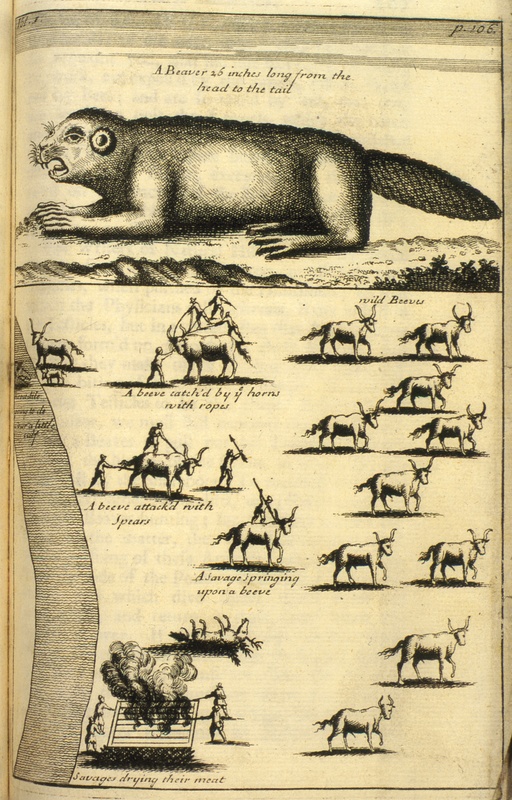
 By all accounts yesterday was a splendid beaver day, with presenters from around the world really swinging the bat hard for beavers. To the right is Frances Backhouse posing with conference organizers Scott McGill and Mike Callahan (in disguise). Here are some highlights from yesterday Sharon and Owen Brown of Beavers: Wetlands and Wildlifeand were presented with the lifetime achievement award, Skip did a very well received presentation on the history of the beaver deceiver (summarized by Malcolm Kenton) and here’s a brief run through of what I’ll be presenting today.
By all accounts yesterday was a splendid beaver day, with presenters from around the world really swinging the bat hard for beavers. To the right is Frances Backhouse posing with conference organizers Scott McGill and Mike Callahan (in disguise). Here are some highlights from yesterday Sharon and Owen Brown of Beavers: Wetlands and Wildlifeand were presented with the lifetime achievement award, Skip did a very well received presentation on the history of the beaver deceiver (summarized by Malcolm Kenton) and here’s a brief run through of what I’ll be presenting today.

The only mess-up of the day is that Emily Fairfax didn’t get time to present her awesome fire dissertation – It was a packed schedule and either things started late after lunch or James Wallace couldn’t squeeze her in – but she was hoping to be able to say something about it last night and in her connections with people She was a good sport of course and Lord knows we’ll be hearing from her again soon!
[wonderplugin_video iframe=”https://youtu.be/BqsB0441TdY” lightbox=0 lightboxsize=1 lightboxwidth=960 lightboxheight=540 autoopen=0 autoopendelay=0 autoclose=0 lightboxtitle=”” lightboxgroup=”” lightboxshownavigation=0 showimage=”” lightboxoptions=”” videowidth=600 videoheight=400 keepaspectratio=1 autoplay=0 loop=0 videocss=”position:relative;display:block;background-color:#000;overflow:hidden;max-width:100%;margin:0 auto;” playbutton=”https://www.martinezbeavers.org/wordpress/wp-content/plugins/wonderplugin-video-embed/engine/playvideo-64-64-0.png”]
Check out these great notes by Malcolm on Skip’s Presentation, Worth A Dam’s Emsissary Doug Noble said he stole the show.
Skip Lisle, inventor of the “Beaver Deceiver,” speaking at #BeaverCON2020:
– The Beaver Deceiver is a flow device, but not all flow devices are beaver deceivers!
– We’re like moose — we like wetlands and we know where to turn to make healthy, productive ecosystems. We need to develop a common language & history.
– We’re lucky to live at a time when there are tremendous opportunities to save society a great deal of money with creative long-term remedies and create tremendous habitats.
– There’s a lot of pushback out there because people are used to wetland areas being drained – the culture associates wetlands/swamps with stagnation, disease, “wasted land” and various unpleasantness. So many places inefficiently keep killing beavers in the same places over and over again.
– In my career at the Penobscot Nation, my friend and I kept trying and building junky flow devices until we came up with the successful trapezoidal concept. The trapezoid had to get larger because they’re attached to the dam. Dam-leak separation makes a flow device more robust. Though they’re smart, beavers don’t do much deductive reasoning and can’t grasp the hollowness of a pipe.
– There’s a lot of controversy about where flow devices can work, but I don’t have any problem with zero inches/feet of water. A dry flow device can do a great job protecting beaver habitat upstream. Getting people to stop killing beavers is another issue — there are wide-open trapping seasons in most of these places.
– Every site is different so I need to put in a lot of thought as to what device best suits the place. Some culvert protectors need floors and some don’t.
– We’ve done enormous damage to wetlands after draining them, but beavers can repair all that if we just stop killing them. One beaver in one month (before moving on) brought so many birds to a site I worked on that weren’t there before. It’s miraculous! Remarkable wildlife viewing spots can be created in very short order. Every town can do this.
– I build simple wood structures to guide beavers’ damming — I don’t use the term “beaver dam analog” because it doesn’t need to look like a beaver dam to get them started.
– You can have a long beaver dam parallel to a road and have the water level much higher than the road, with a few pipes through the dam and under the road, and the road stays dry.
– There’s also an aesthetic and spiritual value to keeping beavers on the land — they’re dynamic, fascinating and all different. They bring a lot of joy to our lives.

A packed house with Doug Noble sitting next to Sherry Guzzi of Tahoe!
[wonderplugin_video iframe=”https://youtu.be/zJ-9aQDK77U” lightbox=0 lightboxsize=1 lightboxwidth=960 lightboxheight=540 autoopen=0 autoopendelay=0 autoclose=0 lightboxtitle=”” lightboxgroup=”” lightboxshownavigation=0 showimage=”” lightboxoptions=”” videowidth=600 videoheight=400 keepaspectratio=1 autoplay=0 loop=0 videocss=”position:relative;display:block;background-color:#000;overflow:hidden;max-width:100%;margin:0 auto;” playbutton=”https://www.martinezbeavers.org/wordpress/wp-content/plugins/wonderplugin-video-embed/engine/playvideo-64-64-0.png”]





















































